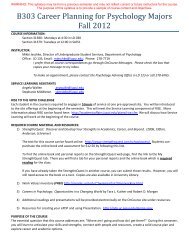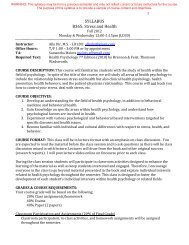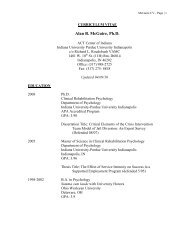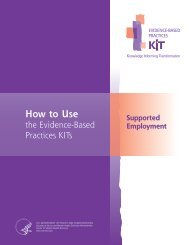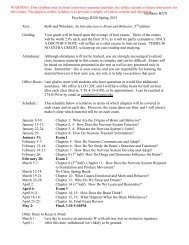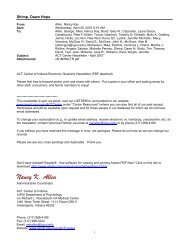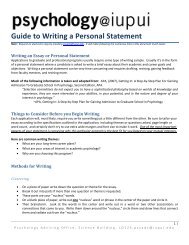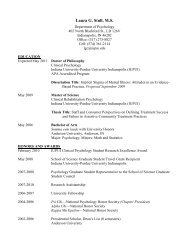Supported Employment: Building Your Program - SAMHSA Store ...
Supported Employment: Building Your Program - SAMHSA Store ...
Supported Employment: Building Your Program - SAMHSA Store ...
- No tags were found...
You also want an ePaper? Increase the reach of your titles
YUMPU automatically turns print PDFs into web optimized ePapers that Google loves.
We strongly encourage you to adapt these formsand incorporate them into your routine paperwork.For printable copies, see the CD-ROM for thisKIT. For a more detailed discussion of theassessment and treatment planning process,see Training Frontline Staff in this KIT.Describe how to maintainconsumer recordsIn your SE policies and procedures, describehow you will maintain consumer records.You must maintain records for each consumerand safeguard them against loss, tampering,and unauthorized use. The records should beconsistent with the Joint Commission (formerlyknown as the Joint Commission on Accreditationof Healthcare Organizations) and Centers forMedicaid and Medicare Services requirements.If you are creating a new recordkeeping system,you will need materials to create records (forexample, binders and forms) and to store themappropriately. You also need written policies andprocedures for documenting and maintainingrecords. Educate your SE team and supervisethem in completing the required documentation.Discuss how to ensure consumers’ rightsIn your SE policies and procedures, discuss howyou will ensure that consumers’ rights are upheld.<strong>Employment</strong> specialists should be aware of thestate and federal consumer rights requirements,especially the Americans with Disabilities Act (ADA).For more information, visit DisabilityInfo.gov.Furthermore, your SE policies and proceduresshould reflect the model’s recovery orientation.Traditional services were developed with abiomedical approach to mental health treatment;they focus on reducing symptoms and preventingrelapse. In contrast, the SE model is based on theconcept of recovery. In the recovery framework,the expectation is that consumers can live a lifein which mental illness is not the driving factorfor their lives. Recovery means more than“maintaining” people with mental illnesses in thecommunity. Recovery-oriented services encourageconsumers to define and fulfill their personal goals,such as a goal to work.<strong>Employment</strong> specialists must believe in and betrue to the recovery principles within the SEmodel. SE teams should be careful not to replicatethose elements of traditional services that simplyemphasize containing symptoms and complyingwith medication.The value of consumer choice in service deliveryand the importance of consumer perceptions mustbe infused in how you provide SE services. Mostpractitioners have never examined their ownattitudes and behaviors about consumer recoveryand, therefore, uncritically accept many clinicaltraditions without paying attention to howdisempowering these practices are for consumers.In recovery-based SE services, establishinga trusting relationship is critical. Interactionswith consumers should be based on mutualityand respect. <strong>Employment</strong> specialists should be challenged tolisten to, believe in, and understand consumers’perspectives and take into account consumers’reasons for “noncompliance.” <strong>Employment</strong> specialists should also focuson consumer-defined needs and preferencesand accept consumer choice in service delivery.SE services provided with a recovery orientationmean that employment specialists put more effortinto supporting and empowering consumers toachieve their individual goals.<strong>Building</strong> <strong>Your</strong> <strong>Program</strong> 35 Tips for Agency Administrators and SE Leaders



